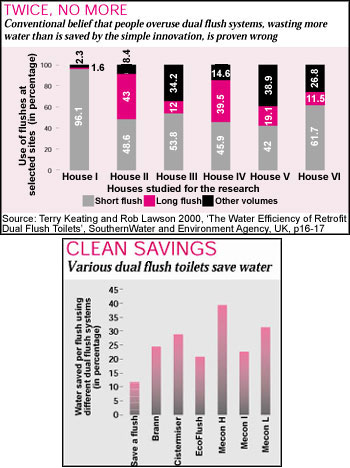Discern, then flush
 allow retrofitting of dual flush toilet systems in the uk, says a recently published report. The research was carried out by SouthernWater, a uk-based company and Environment Agency, a uk-based non-governmental organisation.
allow retrofitting of dual flush toilet systems in the uk, says a recently published report. The research was carried out by SouthernWater, a uk-based company and Environment Agency, a uk-based non-governmental organisation.
The study of the dual flush toilet system has found that replacing single with dual flush cisterns can generate average water savings of 27 per cent in uk households. As a result, Environment Agency is calling for a relaxation in the laws prohibiting retrofitting of dual devices on existing toilets.
The dual system works by allowing the user to choose between a less-water intensive flush, usually three litres, and a longer six-litre flush. Dual flush toilets are actively encouraged across America and Asia, and are mandatory in Australia for new bathrooms. The Australian non-governmental organisation, Savewater, estimates that dual flush toilets have helped Australia save as much water as entire cities of Adelaide and Perth use annually. European countries such as Denmark and Sweden too have for the past decade been converting to dual flush systems.
In most countries, households can choose between installing a new toilet or retrofitting a device on their current one. But under uk law, from 1993 dual flush cisterns were prohibited until the Water Supply (Water Fittings) Regulations 1999 came into force. Dual flushing in new installations is now permitted, although the replacement of existing cisterns is still prohibited.
The original ban in 1993 and the continued ban on replacing cisterns are largely based on the concerns about double flushing. If inappropriate or inadequate devices are installed, and a light flushing is insufficient to clean the pan, users may be obliged to flush a second, or even third time, negating the benefits of the dual system.
But the Southern Water study of 33 households fitted with dual kits found that double flushing only increased by an average of 0.6 per cent compared with the rate of double flushing on single flush toilets.
The study was carried out over eight months using five retrofit devices in West Sussex. It required the relaxation of byelaws prohibiting the use of dual flush systems. The study compared the average volume per flush before and after dual flush installation.
Dramatic results The average dual flush saving observed during the trial was 27 per cent
